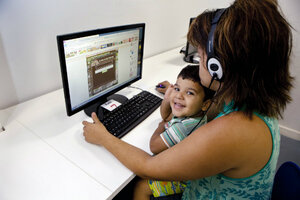Internet security for kids: less parental control, more communication
Internet security for kids tends to mean parental control over websites. A new study says that parental control and restricting access aren't constructive. Kids needn't be sheltered, but allowed to explore with parental support and communication.

Parental control and website blocking are not constructive ways to keep kids safe online, a new study says. Here, Bruna Quaresma and her son, Joao Pedro, use a computer to play games and surf the internet in Rio de Janeiro, Brazil. 2011.
Christian Science Monitor
As a society, we’ve been talking about youth online risk for years, but we’ve only just begun to talk about young people’s resilience, which is what helps them keep risk from turning into harm. It’s important to know, as the authors of an important new report note, that resilience – the ability to deal with negative experiences without being upset by them – doesn’t come from avoiding risk, online or offline.
“Risk and resilience go hand in hand, as resilience can only develop through exposure to risks or stressful events. Consequently, as children learn how to adequately cope with (online) adversities, they develop (online) resilience,” write Leen d’Haenens, Sofie Vandoninck and Verónica Donoso of EU Kids Online in the UK.
Here are some things parents and educators need to know about resilience:
- What it enables: “Resilient children are able to tackle adverse situations in a problem-focused way, and to transfer negative emotions into positive (or neutral) feelings,” the authors write.
- Gender differences: Boys were less resilient at a younger age, girls were less resilient as teenagers.
- Online and offline inseparable: “Children with more psychological problems suffer more from online as well as offline risks” (resonant with findings of a just-released study in the US, published in the journal Pediatrics, about maltreatment's amplifying effect on a child's online vulnerability).
- Most popular coping strategy (but resilient kids usually use more than one): “Talking to somebody is the most popular employed strategy, regardless of the type of risk, especially among girls and younger children who tend to employ this communicative strategy more often.” The authors recommend encouraging “open communication, both at home and at school.”
- Other education needed: Teach children effective coping strategies, including blocking and abuse-reporting tools, but especially social-emotional literacy (I added the latter, based on other research and the authors’ advice that “special attention to children with low self-efficacy and psychological difficulties … is crucial.”
- It’s not either/or, but a spectrum: “Being resilient is not a simple ‘yes or no’ question, and … would rather be understood as a continuum from very low to very high resilience.” Over all, “girls, younger children, children with more psychological problems, those receiving more support from their friends, children whose parents mediated their internet use and children whose parents were low internet users were less resilient.”
- Parents’ own tech use a significant factor: Promoting Net use by parents “is crucial, as parents who are frequent internet users themselves feel more confident with the medium, and also feel more confident in guiding their children … promoting a positive attitude toward online safety and proactive coping strategies.”
- Mediation better than restriction: In terms of parenting style, the authors write that “monitoring or mediating approaches seem to be more beneficial for children’s online resilience than restrictive ones.” They add that more research is needed for different types of risks and on social practices of young people.
- Taking away the Net doesn’t help: It’s related to a passive or fatalistic approach that doesn’t build self-confidence or -efficacy online, the researchers found. “Going offline was related to missing out on online opportunities, and the problem could easily re-occur because the cause had not been tackled.”
- Educators key too: Teachers are needed to “stimulate their pupils to resort to proactive problem-solving strategies,” so “sufficient digital skills among the teachers themselves are therefore essential.”
Zooming in on young people’s top coping strategy: “Talking with somebody” was the most popular one regardless of the problem encountered,” according to the report. In the case of bullying, 77% of the victims talked to someone after an incident; 53% “did so after seeing disturbing sexual content.” But they often use several strategies at once – for example, “deleting unwelcome messages [41%] and blocking the sender [46%]” in cases of bullying and 38% and 40%, respectively, in cases of sexting. Did that help? Yes, the authors found, 92% of young people who reported deleting unwelcome sexual content and 78% of those who blocked the sender in bullying cases said those strategies helped.
It’s great to see research turning up substantive evidence of young people’s resourcefulness as well as resilience online. Remember that this research is based on surveys of more than 25,000 youth in 25 countries.
The Christian Science Monitor has assembled a diverse group of the best family and parenting bloggers out there. Our contributing and guest bloggers are not employed or directed by the Monitor, and the views expressed are the bloggers' own, as is responsibility for the content of their blogs. Anne Collier blogs at NetFamilyNews.

